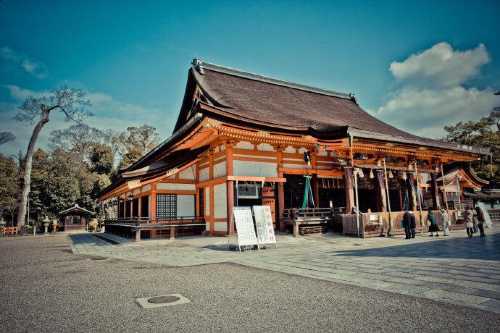Popular Trip Moments
⛩️ Let’s Go to Fushimi – Kyoto’s Sake & Shrine Wonderland! 🍶 | Anti-War Journey: Best Photo Spots in Kansai | Kyoto Leisure Hotel | Grand Prince Hotel Kyoto | Yasaka Shrine: Kyoto’s Spiritual Gateway | Kyoto City Attractions: Okazaki Shrine and Heian Shrine | Above the Clouds at Mount Hiei – Japan | Charming Views at Mount Hiei Garden Museum – Japan | [Kyoto] Ninenzaka and Sannenzaka | [Kyoto] Entoku-in Temple | Stone Bridge and Still Waters at Maruyama Park – Kyoto | [Kyoto] Yasui Shrine (Yasui Konpiragu Shrine) | A Gentle Walk to Kifune Shrine – Kyoto | Kyoto's Kiyomizu-dera: A Sanctuary for the Soul | Kyoto Attractions: Higashi Honganji, Kinkaku-ji, and Ginkaku-ji | Sightseeing along Kyoto and Osaka | 3-Day Escape to Kyoto | 🏨 Hotel Excellence Review | Near JR Kyoto, great value | Kiyomizu-dera Temple and Surrounding Attractions in Kyoto | Path of Light: Kyoto's Beauty Blooms in the Kimono Forest | A Hidden Art Deco Gem in Kyoto: La Maison Icart Art Museum | Enveloped in the Magic of Colors: A Unique Space in Arashiyama Created by Light and Water | Do you know about this hidden gem of a route in Japan? | The Mirror World of Green Maple Leaves Reflected in Your Heart 🪞 | The tranquility touches the soul. Enjoy a moment of peace at the moss and bamboo of Gio-ji Temple. | 💠Hydrangea blooming in your mouth. A bouquet to eat, a happy day in the rainy season. | 🪼Life list +1: Kyoto Aquarium is really worth it! | Osaka·Kyoto·Tokyo: Hoshino Resorts' OMO Hotels Perfect for City Tour | Umekoji Park, a great family spot with abundant facilities near Kyoto Station | Kyoto Gion Festival: A Midsummer Celebration Across a Millennium | All the boys love it🤍【Kyoto Railway Museum】
Trending Travelogues
Recommended Attractions at Popular Destinations
Popular Attractions in Bangkok | Popular Attractions in Manila | Popular Attractions in Tokyo | Popular Attractions in Taipei | Popular Attractions in Hong Kong | Popular Attractions in Seoul | Popular Attractions in Kuala Lumpur | Popular Attractions in Los Angeles | Popular Attractions in Shanghai | Popular Attractions in New York | Popular Attractions in Shenzhen | Popular Attractions in Osaka | Popular Attractions in Singapore | Popular Attractions in London | Popular Attractions in Guangzhou | Popular Attractions in San Francisco | Popular Attractions in Beijing | Popular Attractions in Macau | Popular Attractions in Bali | Popular Attractions in Jakarta | Popular Attractions in Paris | Popular Attractions in Ho Chi Minh City | Popular Attractions in Istanbul | Popular Attractions in Phuket | Popular Attractions in Chicago | Popular Attractions in Seattle | Popular Attractions in Toronto | Popular Attractions in Orlando | Popular Attractions in Cebu | Popular Attractions in Chiang Mai
Popular Restaurants in Kyoto
Gion Maruyama | Kikunoi Honten | Gion Matayoshi | Kyo-Suiran | Nanzenji Junsei | Kinmata | Isshi Souden Nakamura | Kikunoi Roan | Ogata | Gion Kawakami | Kodaiji Wakuden | Honwaka Kyoto Honten | Sakuragawa | Yamamoto Menzou | KYOTO GION KOME-RYOTEI HACHIDAIME GIHEY | Tempura Yoshikawa | Tagawa | Uosaburo | HANA-Kitcho | Okabeya | cenci | Pound Kyoto Ekimae | Shimogamosaryo | Mitsuyasu | Kifune Ugenta | Shunai Sasaki | Honke Tankuma Honten | Touzan - Hyatt Regency Kyoto | Mizuki | Hirokawa
Popular Ranked Lists
Top 50 Must-Visit Restaurants in Dalat | Top 50 Must-Visit Restaurants in Koh Samui | Popular Premium Hotels in Nakhon Pathom Province | Top 50 Must-Visit Restaurants in Jeju | Top 50 Must-Visit Restaurants in Sanya | Top 10 Trending Attractions in Harbin | Top 50 Must-Visit Restaurants in Chongqing | Popular Premium Hotels in Warnemunde | Popular Premium Hotels in Central Kalimantan | Popular Trending Attractions in Changzhou | Top 10 Trending Attractions in Wuhan | Popular Trending Attractions in London | Popular Premium Hotels in Ustka | Top 50 Must-Visit Restaurants in Chiang Mai | Popular Premium Hotels in Tegernsee | Top 10 Trending Attractions in Qinhuangdao | Top 50 Must-Visit Restaurants in Osaka | Top 50 Must-Visit Restaurants in Langkawi | Popular Trending Attractions in New York | Top 50 Must-Visit Restaurants in Athens | Popular Premium Hotels in Iasi | Popular Premium Hotels in Bujumbura Mairie | Top 50 Must-Visit Restaurants in Kuala Lumpur | Popular Premium Hotels in Tours | Top 50 Must-Visit Restaurants in Bangkok | Top 50 Must-Visit Restaurants in Barcelona | Top 20 Luxury Hotels near Goyang-si | Popular Trending Attractions in Lianyungang | Popular Luxury Hotels in Flacq | Top 50 Must-Visit Restaurants in Shanghai
About
Payment Methods
Our Partners
Copyright © 2025 Trip.com Travel Singapore Pte. Ltd. All rights reserved
Site Operator: Trip.com Travel Singapore Pte. Ltd.
Site Operator: Trip.com Travel Singapore Pte. Ltd.









